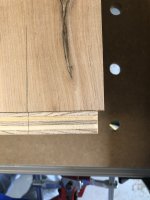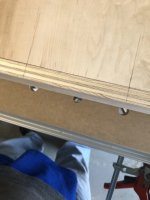Ray.DuBose
Member
- Joined
- Oct 11, 2019
- Messages
- 27
New Festool Owner here, just purchased a TS75, Domino 700, Midi Dust Extractor and a MFT/3 table.
Use to working with table saw and standard joinery, making 3/4 plywood box for the wife and nothing seems to line up.
Breaking down Sheet goods with the TS75 and 1900 track, I measure 26" cut and it's like a mm or two short of that. Doing some reading it looks like may need to make sure my track is on my good side not my track side. Not 100% sure how I had it originated looking back but I'm guessing my 1-2mm is the saw kerf.
Not sure what's going on with the domino. laid out my parts and scribed my lines.. popped dominos in and put them together and it's like it shifted 5mm or so down so down. not sure at all how this happened.
Not sure what happened, more frustrated with myself than anything I guess and be more aware were my cut lines are. Cutting on the MFT3 table is usually fine but I'm aligning the scribe line to the kerf the saw cut in the MDF. Also need to figure out why my domino isn't sliding very smooth and sometimes jerks when it starts to go in the wood, maybe I'm pushing to fast.
Ray
Use to working with table saw and standard joinery, making 3/4 plywood box for the wife and nothing seems to line up.
Breaking down Sheet goods with the TS75 and 1900 track, I measure 26" cut and it's like a mm or two short of that. Doing some reading it looks like may need to make sure my track is on my good side not my track side. Not 100% sure how I had it originated looking back but I'm guessing my 1-2mm is the saw kerf.
Not sure what's going on with the domino. laid out my parts and scribed my lines.. popped dominos in and put them together and it's like it shifted 5mm or so down so down. not sure at all how this happened.
Not sure what happened, more frustrated with myself than anything I guess and be more aware were my cut lines are. Cutting on the MFT3 table is usually fine but I'm aligning the scribe line to the kerf the saw cut in the MDF. Also need to figure out why my domino isn't sliding very smooth and sometimes jerks when it starts to go in the wood, maybe I'm pushing to fast.
Ray


